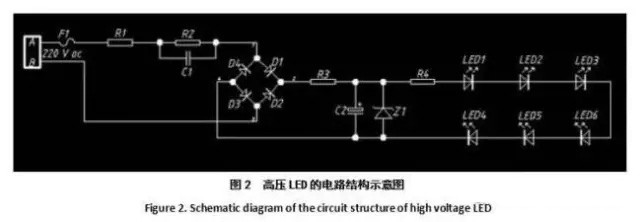In recent years, the global energy crisis has intensified, and conventional energy sources have been unable to meet the needs of world economic development. As an important renewable green energy source, solar energy has been favored by countries all over the world. The solar semiconductor lighting system integrates the advantages of semiconductor and solar energy resources, effectively improving lighting efficiency and green energy saving. In practical applications, it should increase the analysis and research of solar semiconductor lighting systems, and give full play to the advantages of solar semiconductor lighting systems.
Overview of solar semiconductor device characteristics
The solar semiconductor is mainly composed of an optical system, an electrode, a PN junction chip, etc., and the illuminant area of ​​the wafer is about 0.025 square millimeter. The whole illuminating process goes through three stages: injecting carriers under forward bias conditions; optical energy transmission; composite radiation . A semiconductor wafer is encapsulated in an epoxy resin. When electrons flow through the wafer, positively charged electrons and negatively charged electrons recombine in the hole region, and holes and electrons disappear to generate photons, photon energy and holes, and electrons. The band gap is proportional, and the light color corresponds to the photon energy. According to the visible light spectrum analysis, the red light and the orange light have the least light energy, and the purple light and the blue light have the most light energy.
With the rapid development of packaging technology and material technology, the green LED light efficiency is about 50lm/W, and the orange and red LED light efficiency is 100lm/W. The full color, high brightness and high efficiency of LED are more and more applicable. Widely used, especially in outdoor lighting systems. LEDs achieve all the visible light in terms of chromaticity, especially the emergence of ultra-high brightness white LEDs, which promotes the rapid development of illumination sources.
In general, light intensity 1cd is the boundary between high-brightness LED and ordinary LED. GalnAs, AILnGaP and A1GaAs materials are mainly used to process high-brightness LEDs. High-brightness red LEDs use A1GaAs material, high-brightness yellow-green, yellow, orange. The red LED uses AILnGaP, and the high-brightness violet, blue and dark green LEDs use GalnAs.
LED semiconductors have high luminous efficiency. The luminous efficacy of tungsten halogen lamps and incandescent lamps is 12~20 lumens/watt, high-pressure sodium is 90~130 lumens/watt, fluorescent lamps are 50~60 lumens/watt, and the spectrum is narrow and the monochromaticity is good. It does not need to be filtered to emit colored visible light. At the same time, LED is an all-solid illuminant, which is resistant to shock and shock, and is not easily broken. It can be developed into a small and light lighting product, which is convenient for maintenance, repair and installation. Moreover, the startup time of the LED light source is short, and the characteristics of the gas discharge light source largely determine the startup time. The semiconductor light source encapsulated by epoxy does not contain components such as filaments, glass and the like which are easily damaged, and can pass through. Shock and vibration.
Solar semiconductor lighting system design
(1) System composition
The solar semiconductor lighting system consists of a semiconductor lighting load, a controller, a Battery , and a solar cell . The standby power supply is set in the basic structural frame. Through the standby power supply, the semiconductor lighting load can be continuously supplied by the backup power source even if it is continuously raining for a long time. To ensure that the solar semiconductor lighting system can operate safely and stably when the battery cannot be powered in time.
When the solar semiconductor lighting system is in operation, solar radiation can be converted into electric energy through solar cells. The solar radiation intensity and temperature have a direct impact on the solar cell output power. When the radiation intensity is weak and the temperature is low, the battery output power cannot always be stable. Sexuality, therefore, it is necessary to store electrical energy in time through the battery during the period of high solar radiation intensity, so that it is convenient to supply power to the semiconductor lighting system reliably and stably during the operation of the lighting system.
The controller is the core of the solar semiconductor lighting system. The controller scientifically manages the battery charging and discharging process, effectively controls the working state of the lighting system, and enables the solar semiconductor lighting system to operate smoothly under different working conditions.

lithium-ion battery, LiFePO4 Battery ; Lithium battery, rechargeable battery pack, Lithium Battery Pack, Long life Lithium Battery
long life battery, 12V Solar Battery , battery for 48v system, Lithium Battery bank, lifepo4 battery pack
Feature:
Low self-discharge rate : ≤ 5%/ month;
Wide working temperature, easy run in low or hot temperature environment(-20ºC ~ 90ºC );
Flexible & Small Form Factor: 1/3 weight of lead acid;
Our battery is adopted as Lithium Iron Phosphate, which has been widely used in municipal new energy buses, new energy vehicles, communication base stations, and computer rooms.
LiFePO4 Battery Replace Lead Acid Battery
Lithium Battery Pack, LiFePO4 Battery Replace Lead Acid Battery, Lithium Battery Pack Product in China, LiFePO4 Battery common use
Starlight Power Industrial Company Limited , https://www.starlite-power.com